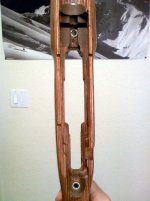HERE ARE A FEW LINKS
http://www.charm.net/~kmarsh/bed.html
http://www.ranchtrippin.com/bedding/
http://www.rdprecision.net/diy2.html
Well had a go my self a few years ago,i couldn't find marine tex so i used jb weld.
As you can see done in the kitchen
Mask the stock and fill every hole,epoxy resin want to go there.(kid's play clay is good)
I also lightly dremmeled the alloy area's on the stock,as a key for the resin.
Carefully put masking tape on the lug,do a good job .Cover each surface,and trim with a sharp knife.
Cover the barrel and lug in a release agent,i used kiwi neutral boot polish.I put a couple coat of this on most of the barrel and action,i rubbed it in well but did not polish it.I also pull a coating of bees wax on the action screw's.Jb weld is easy to mix,i just emptied both tube's and mixed it.No measuring etc.
I used an old tea spoon and put the resin on the area's i wanted to bed,but i think i put a bit too much there.
DON'T PANIC put the action back in the rifle ,don't forget the floor plate.
Lightly tighten the screw's and watch the resin ouse out.Clean up the excess jb weld,you can use vinegar but i was a bit nervous about using it(it an acid and i didn't want a rusty gun).Gale McMillan recommends kerosene in his clean up method.I didn't have any kerosene, petrol lighter fuel did the same thing.So got some old rag's and cleaned up with lighter fuel,be careful no smoking etc..8 hours later i slackened the action screws,and to my great joy the action popped out ok.
I was quite pleased with my first attempt

of bedding.
I just read all the links above,but the down side is you could glue that action in just be careful :!:
P.S
The second time i did it was a lot easer.
_________________


